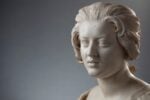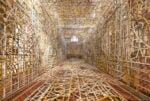Angelo Sarleti / Michele Tocca
.jpg)
La Galleria FuoriCampo inaugura la quarta mostra in programma per il primo temporary a Bruxelles in Rue Léon Lepage 49, presentando due pittori italiani, Angelo Sarleti (Reggio Calabria, 1979) e Michele Tocca (Subiaco, 1983).
Comunicato stampa
ALLEGORIA. LA PITTURA OLTRE SE STESSA
curated by Alberto Mugnaini
MICHELE TOCCA
ANGELO SARLETI
On Friday June 13, the FuoriCampo Gallery inaugurates its fourth scheduled exhibition for the first temporary show at 49, Rue Léon Lepage, presenting two italian painters, Angelo Sarleti (Reggio Calabria, 1979) and Michele Tocca (Subiaco, 1983). The exhibition, curated by the critic Alberto Mugnaini, constitutes an initial occasion for reflection and analysis on painting, that will continue in the space in Siena, exploring the dialogue between the two artists.
A.M. Painting rediscovers itself on the borders of the invisible, that which “signifies” is the invisible: Tocca’s painting inherits the strokes and marks of a certain 20th century Italian figurative tradition, while the tradition of Sarleti re-echoes the spatial and geometric combinations of modernism: this is the “letter” of their painting. But both offer us something not seen before, something that they share: a sort of realism of the invisible, which goes beyond the status of a phenomenon, the here and now, and assumes a “panoramic” dimension in the sense of time. In Tocca, painting finds the responsibility of representing a dimension that is extended through time, as if through a chronological stretching, it seeks a permanence that the shadowy and ephemeral nature of the visual phenomenon, in their open evidence, conceal. Behind the marks of abstraction, Sarleti grasps and verifies a substantial reality, the gathering of data from experience and from a scientific comparison between them, giving a body to the ghosts of mathematics, represents a representation, that representation that belongs to statistics, giving new meaning, and life-blood and energy, to the impoverished geometrical combinations of a century of non-iconic painting.
M.T. Why Angelo and I? Where do two works that are so distant from each other meet up?
Many people would have been led to reflect on formal aspects, on a certain taste for investigation and the analysis of signs, of materials and composition. Yet this is not enough.
I pick up on the term “responsibility”, cited by Alberto, because it is here that I find the real meeting point between the two works. It’s here that the two paths meet. A responsibility that is more an investiture than a result, and that tension, between highs and lows, successes and failures, is a motivation for the work.
A.S. Alberto, the beginning of your reflection, on signifying the invisible in a modernist or figurative guise, sheds light on another conviction that we certainly share.
When it comes to art history, we are not only interested in iconographical or technical aspects, usable in post-modern terms, but also in the structure of the work as a whole. That internal engineering that allows the painting to become meaningful, and its ability to manifest its contents.
Michele, Heisenberg’s principle of indetermination tells us that we can alter the universe by observing it.
I think that artists have always had this awareness, and this can also explain the necessary responsibility in creating art.
The exhibition, which is open for viewing until June 26, concludes the cycle of exhibitions devoted to the latest generations of Italian art whom the gallery has promoted in the last year of its activity in Siena, and which has continued in the last few months in which it has been in the Belgian city, on the eve of Italy’s duty Presidency of the European Union Council.
Painting, and two protagonists of the art of painting, are left with the task of saying the last (temporary) word in an ongoing discourse that directs people’s attention to the role of art, and its rules.
Specia thanks to Cantina Argiano, Montalcino (SI) www.argiano.net
B
iographies
A
ngelo Sarleti (born in Reggio Calabria nel 1979; lives and works in Milano)
A
mong his most recent and significant exhibition projects, solo show: MAMMONA (2012), Bilionaires (2009) e Not here (2006), galleria ARTRA, Milan; among the main group exhibitions, remember: 2011 Becoming rather then being, NABA Nuova Accademia di Belle Arti (Milan), Careof DOCVA (Milan) and Vessel (Bari), 2008 Arrivi e Partenze, Mole Vanvitelliana (Ancona), 2004 Empowerment Cantiere Italia, Museo d’arte contemporanea Villa Croce and Palazzo Bombrini (Genoa). Among the residency programs and workshops in which he took part: Centre International d’Accueil et d’Echanges des Récollets, 2006 Dena Foundation for Contemporary Art, Parigi; 2003 Networking, Prato (visiting professor Meshac Gaba). In 2011 Angelo Sarleti has also worked to realize infographics for the yearbook scientific IRCCS Fondazione Don Gnocchi, Milan.
M
ichele Tocca (born in Subiaco in 1983, lives and works in London). He completed an MA Painting at the Royal College of Art in London, having studied painting at the Academy of Brera in Milan and Antwerp in Belgium (KASKA).
Among the main exhibitions, remember Studiolo # 10, Milan (2014 solo); Landina, various locations c/o CARS, Omegna (2013); L’artista nel sistema e il suo tempo, Castel di Ieri, AQ (2013); Lumen, MARS, Milan (2013); Moments Around us, Idea Store Whitechapel, London (2012); La pittura, isola, Bianca Gallery, Palermo (2012); Difetto come indizio del desiderio, neon-Campobase, Bologna (2011); Appunti di Pittura, MARCA, Catanzaro (2011); Impresa Pittura, CIAC, Genazzano (2010); Z-Time, Blyth Gallery, London - Moscow Biennale, Moscow (Ru); En plein air Galleria/Galleria, Ortona (Ch), 2010; No more than a point of view, Prague Biennale IV (2009); ICI, Otto Zoo, Milan (2008); Binocular, Kingsgate Gallery, London (2008)
Programma FuoriCampo Temporary Space Bruxelles
1/4
GIOVANNI KRONENBERG
MARCO ANDREA MAGNI
opening 23 April
23 April - 7 May 2014
2/4
SERENA FINESCHI
opening 8 May
8 May - 24 May 2014
3/4
ANNA MOSTOSI / EUGENIA VANNI / SERENA VESTRUCCI
opening 28 May
28 May - 12 June 2014
4/4
ANGELO SARLETI / MICHELE TOCCA
opening 13 June
13 June - 26 June 2014
4/4
FUORICAMPO TEMPORARY SPACE
ALLEGORIA. LA PITTURA OLTRE SE STESSA
a cura di Alberto Mugnaini
MICHELE TOCCA
ANGELO SARLETI
La Galleria FuoriCampo inaugura venerdì 13 giugno la quarta mostra in programma per il primo temporary a Bruxelles in Rue Léon Lepage 49, presentando due pittori italiani, Angelo Sarleti (Reggio Calabria, 1979) e Michele Tocca (Subiaco, 1983). La mostra, a cura del critico Alberto Mugnaini, costituisce il primo momento di riflessione e analisi sulla pittura che proseguirà nello spazio di Siena approfondendo il dialogo tra i due artisti.
A.M. La pittura ritrova se stessa ai confini dell’invisibile, quello che “significa” è l’invisibile: la pittura di Tocca eredita i tocchi e le macchie di una certa tradizione figurativa italiana del Novecento, quella di Sarleti riecheggia le combinazioni spaziali e geometriche del modernismo: questa la “lettera” della loro pittura. Ma entrambi ci propongono qualcosa di inaudito, che li accomuna: è una sorta di realismo dell’invisibile, che va oltre il dato fenomenico, il qui e ora, e assume una dimensione “panoramica” in senso temporale. La pittura ritrova in Tocca la responsabilità di rappresentare una dimensione allungata del tempo come attraverso uno stiramento cronologico, cerca una permanenza che il dato umbratile e passeggero del fenomeno visivo, nella loro aperta evidenza, occultano. Sarleti, dietro le cifre dell’astrazione, coglie e verifica una realtà sostanziale, la raccolta dei dati dell’esperienza e del loro scientifico raffronto, dando un corpo ai fantasmi della matematica, rappresenta una rappresentazione, quella propria delle statistiche, ricaricando di senso e rinsanguando di energia le depauperate combinazioni geometriche di un secolo di pittura aniconica.
M.T. Perché Angelo ed io? due lavori così distanti dove si incontrano?
Molti sarebbero portati a riflettere su aspetti formali, su un certo gusto per l’indagine e l’analisi dei segni, della materia e la composizione. Eppure questo non basta.
Riprendo il termine “responsabilità”, citato da Alberto, perché è qui che trovo il vero punto d’incontro tra i due lavori. Qui che si incontrano i due sentieri. Una responsabilità che è più un’investitura che un risultato e quella tensione, tra alti e bassi, successi e fallimenti, motiva il lavoro.
A.S. Alberto,
l'inizio della tua riflessione sul significare l'invisibile con veste figurativa o modernista, mette in luce un'altra convizione che sicuramente ci accomuna.
Della storia dell'arte non ci interessa soltanto l'aspetto iconografico o tecnico, utilizzabile in termini postmoderni, ma la struttura dell'opera nella sua totalità.
Qell'ingegneria interna che permette al quadro di diventare significante e la sua capacità di manifestare il proprio contenuto.
Michele,
il Principio di indeterminazione di Heisenberg, ci dice che possiamo modificare l'universo osservandolo.
Io penso che gli artisti abbiano sempre avuto tale consapevolezza e questa può anche spiegare la necessaria responsabilità nel fare arte.
La mostra, visibile fino al 26 giugno, conclude il ciclo di mostre dedicato alle ultime generazioni dell'arte italiana che la galleria ha promosso nell'ultimo anno di attività a Siena e proseguito negli ultimi mesi di permanenza nella città belga, alla vigilia del semestre di Presidenza italiana del Consiglio dell’Unione Europea.
Si ringrazia per la partecipazione esclusiva di Cantina Argiano, Montalcino (SI) www.argiano.net
Biografie
Angelo Sarleti (nato a Reggio Calabria nel 1979; vive e lavora a Milano)
Tra i suoi più recenti e significativi progetti espositivi, le personali MAMMONA (2012), Bilionaires (2009) e Not here (2006), realizzate presso la galleria ARTRA di Milano; tra le principali mostre collettive ricordiamo: nel 2011 Becoming rather then being presso NABA Nuova Accademia di Belle Arti (Milano), Careof DOCVA (Milano) e Vessel (Bari), nel 2008 Arrivi e Partenze, Mole Vanvitelliana (Ancona), e nel 2004 Empowerment Cantiere Italia, Museo d’arte contemporanea di Villa Croce e Palazzo Bombrini (Genova). Tra i programmi di residenza e workshop internazionali a cui ha preso parte, Centre International d’Accueil et d’Echanges des Récollets nel 2006 presso la Dena Foundation for Contemporary Art di Parigi e Networking, Prato nel 2003 (visiting professor Meshac Gaba). Nel 2011 Angelo Sarleti si è inoltre occupato di realizzare e curare le infografiche per l'annuario scientifico dell'IRCCS Fondazione Don Gnocchi, Milano.
Michele Tocca (nato a Subiaco nel 1983, vive e lavora a Londra). Ha completato un MA Painting al Royal College of Art di Londra, dopo aver studiato pittura all’Accademia di Brera di Milano e ad Anversa in Belgio (KASKA).
Tra le principali mostre, si ricordano Studiolo#10, Milano (2014, solo); Landina, sedi varie c/o CARS, Omegna (2013); L’artista nel sistema e il suo tempo, Castel di Ieri, AQ (2013); Lumen, MARS, Milano (2013); Moments Around us, Idea Store Whitechapel, Londra (2012); La pittura, isola, Galleria Bianca, Palermo (2012); Difetto come indizio del desiderio, Neon-Campobase, Bologna (2011); Appunti di Pittura, MARCA, Catanzaro (2011); Impresa Pittura, CIAC, Genazzano (2010); Z-Time, Blyth Gallery, Londra – Moscow Biennale, Mosca (Ru); En plein air, Galleria/Galleria, Ortona (Ch), 2010; No more than a point of view, Prague Biennale IV, (2009); ICI, Otto Zoo, Milano (2008); Binocular, Kingsgate Gallery, Londra (2008).



